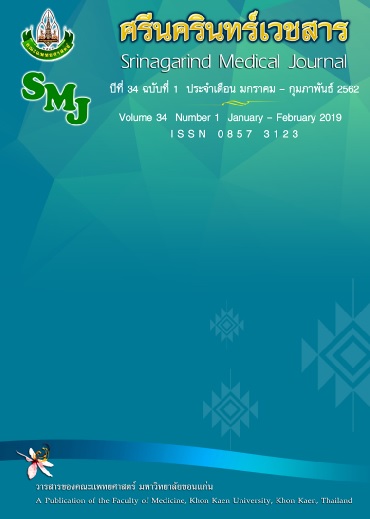A Study of Statistical Data of Mammogram
Keywords:
Mammography; breast cancer,statistical data; mass; microcalcificationAbstract
Background and Objective: A mammogram is commonly used to detect breast cancer and details of glandular tissue. A mammography can represent the mass and localization of a lesion. But mammography cannot define the type of observed lesion. For accurate diagnosis, a biopsy is needed to confirm the initial examination. The variety of tissues (both lesion and normal tissue) represent as different image data in mammography. It may be possible to separate different tissues by using image data.The aim of this study was to determine the difference of statistical data in differing breast tissues as observed in mammography.
Methods: Eighty-nine mammography images with lesions of different types (mass or microcalcification) were obtained and studied from an online database: The Mini-MIAS International Congress Series 1069. The statistical data (skewness, kurtosis, standard deviation, integrated density, mean, and median) were measured. The mean difference of image data was analyzed by one-way ANOVA or Kruskal-Wallis tests for normal or non-normal distribution data, respectively.
Results: Results show that the integrated density and the kurtosis could separate the mass from microcalcifications. The mean could separate normal tissue from the lesions as well. Sensitivity of mass and microcalcifications were 87.5% and 88.89%, respectively. Specificity of normal tissue was 100%.
Conclusion: The difference of the image data could help to diagnosis different breast lesions.
References
2. National Cancer Institute. Hospital-Based Cancer Registry2012.Bangkok: National Cancer Institute; 2014.
3. Department of Surgery, Faculty of Medicine Siriraj Hospital. Breast Cancer.[Internet].22 February 2015 [cited Feb 22,2015]. Available from: www.si.mahidol.ac.th/th/department/surgery/
4. Oliver A, Freixenet J, Marti J, Perez E, Pont J, Denton ERE, et al. Pattern recognition. A review of automatic mass detection and segmentation in mammographic images. Med Image Anal 2010; 14: 87–110.
5. American Cancer Society. Cancer facts and figures 2006. Atlanta, GA: American Cancer Society. [Internet]. 2 February 2015 [cited Feb 2, 2015]. Available from: http://www.cancer.org
6. Nithya R, Santh B. Mammogram analysis based on pixel intensity mean features. J Computer Sci 2012; 8: 329-32.
7. Dubey RB, Hanmandlu M, Gupta SK. A comparison of two methods for the segmentation of masses in the digital mammograms. Comput Med Imaging Graph 2010; 34: 185–91.
8. Cheng HD, Shi XJ, Min R, Hu LM, Cai XP, et al. Approaches for automated detection and classification of masses in mammograms. Pattern Recognition.2006; 39: 646 – 68.
9. Mohamed H, Mabrouk MS, Sharawy A. Computer aided detection system for micro calcification sindigital mammograms. Comput Methods Programs Biomed 2014; 116: 226-35.
10. Lehman CD, Wellman RD, Buist DSM, Kerlikowske K, Tosteson ANA, et al. Diagnostic accuracy of digital screening mammography with and without computer-aided detection. JAMA Intern Med 2015; 175: 1828-37.
11. Fenton JJ, Onega T, Zhu W, Balch S, Smith-Bindman R, Henderson L, et al. Validation of a medicare claims-based algorithm for identifying breast cancers detected at screening mammography. Med Care 2016; 54: e15–22.
12. Jebathangam J, Purushothaman S, Rajeswari P. Application of echo state neural network in identification of microcalcification in breast. Digital Image Processing 2016; 8: 45-50.
13. Yudong Z, Xiao JY, Carlo C, Zhengchao D, Ti FY, et al. Abnormal breast detection in mammogram images by feed-forward neural network trained by jayaalgorithm. Fundamenta Informaticae 2017; 151: 191-211.
14. Chiranji LC, Acharjya DP. Breast cancer detection using intuitionistic fuzzy histogram hyperbolization and possibilitic fuzzy c-mean clustering algorithms with texture feature based classification on mammography images. Proceedings of the International Conference on Advances in Information Communication Technology & Computing; New York, USA. 2016.
15. Osman MA, Darwish A, Khedr AE, Ghalwash AZ, Hassanien AE. Enhanced breast cancer diagnosis system using fuzzy clustering means approach in digital mammography. In: Hassanien A, Gaber T, (Eds.). Handbook of Research on Machine Learning Innovations and Trends Hershey, PA: IGI Global. 2017: 925-41.
16. The Mammographic Image Analysis Society. The Mini-MIAS Database of Mammograms. [Internet]. 24 May 2015 [cited May 25, 2015]. Available from:http://www.mammoimage.org/databases/
17. National Institutes of Health (NIH). Image J. [Internet]. 24 February 2015 [cited Feb 24, 2015]. Available from: https://imagej.nih.gov/ij/
18. National Institutes of Health (NIH). ImageJanalzye. [Internet]. 25 June 2015 [cited June 25, 2015]. Available from: https://imagej.nih.gov/ij/docs/guide/146-30.html#toc-Subsection-30.1
19. IBM. IBM SPSS Statistics Base 22.0. [Internet]. 5 March 2015 [cited Mar 5, 2015]. Available from:http://www.ibm.com/software/ analytics/spss/products/statistics/requirements.html.
20. Parikh R, Mathai A, Parikh S, Chandra Sekhar G, Thomas R. Understanding and using sensitivity, specificity and predictive values. Indian J Ophthalmol 2008; 56: 45-50.
21. Muthu Rama Krishnan M, Shuvo Banerjee, Chinmay Chakraborty, Chandan Chakraborty, Ajoy K Ray. Statistical analysis of mammographic features and its classification using support vector machine. Expert Systems with Applications 2010; 37: 470-8.




